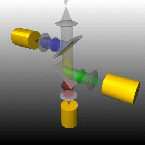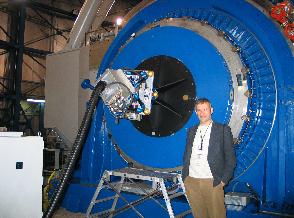ULTRACAM
ULTRACAM is a high-speed, 3-channel CCD camera for astrophysical research.
Dichroics split the light up into ultraviolet, visual and red wavelengths
which are exactly simultaneously imaged with frame transfer CCDs (1024 by 1024 imaging area).
These CCDs use a masked area to shunt exposures rapidly from the imaging area,
which can then be read out while the next exposure is running. Timestamps are generated from
the GPS.
Links
- Tips for observing with ULTRACAM
- Data logs
- Pipeline
installation instructions
- Pipeline software
- Calibration information
- Publications
- Vik
Dhillon's ULTRACAM web pages
ULTRACAM design
 This picture shows the schematic design of ULTRACAM: light from the
telescope is first collimated and then split into different
wavelengths with dichroics. Each channel is then re-imaged onto its
own CCD. Each CCD is a frame transfer device, which allows a
dead-time of only 0.026 seconds in the normal readout mode. A special
"drift mode" allows much faster operation, with frame rates of over
100 Hz.
This picture shows the schematic design of ULTRACAM: light from the
telescope is first collimated and then split into different
wavelengths with dichroics. Each channel is then re-imaged onto its
own CCD. Each CCD is a frame transfer device, which allows a
dead-time of only 0.026 seconds in the normal readout mode. A special
"drift mode" allows much faster operation, with frame rates of over
100 Hz.
ULTRACAM can produce lots of data, up to 3 MB per
second. Over the course of the night, this can stack up to many
gigabytes. We have developed software to allow us to look at and
reduce the data in near real-time.
ULTRACAM at the WHT
 This photograph shows ULTRACAM mounted on the 4.2m WHT
in La Palma during the commissioning run in May 2002. The black
tube with flanges at the top of the picture is the mounting collar for
connecting to the WHT; the telescope focus is located in the middle of
the tube at the top of the picture.The large silver box at the bottom
houses the SDSU CCD controller which drives the readouts of all three
CCDs. One of the CCDs can be seen as a smaller silver box on top of
the SDSU controller. ULTRACAM is very approximately 0.5m wide, deep
and high.
This photograph shows ULTRACAM mounted on the 4.2m WHT
in La Palma during the commissioning run in May 2002. The black
tube with flanges at the top of the picture is the mounting collar for
connecting to the WHT; the telescope focus is located in the middle of
the tube at the top of the picture.The large silver box at the bottom
houses the SDSU CCD controller which drives the readouts of all three
CCDs. One of the CCDs can be seen as a smaller silver box on top of
the SDSU controller. ULTRACAM is very approximately 0.5m wide, deep
and high.
This 3.6MB animated gif shows an area around an
eclipsing white dwarf/M dwarf binary called NN Ser during its
eclipse. The right-hand panel shows the light-curve. Only 1 in 5 frames
are plotted to keep the file size down. The data were taken with 2 second exposures.
ULTRACAM at the the VLT
 In May 2005 we had our first run with ULTRACAM at the visitor focus of the VLT (UT3, Melipal).
We were allocated a block of nights, 4 to 21 May, to undertake some 15 projects. The weather was kind
and we obtained some beautiful data, which will appear here at some point in the future.
In May 2005 we had our first run with ULTRACAM at the visitor focus of the VLT (UT3, Melipal).
We were allocated a block of nights, 4 to 21 May, to undertake some 15 projects. The weather was kind
and we obtained some beautiful data, which will appear here at some point in the future.
Acknowledgements
ULTRACAM was funded by PPARC and is a collaboration
between Vik Dhillon (Sheffield),
Tom Marsh (Warwick) and the Astronomy Technology
Centre (Edinburgh).
Tom Marsh, Warwick
 This picture shows the schematic design of ULTRACAM: light from the
telescope is first collimated and then split into different
wavelengths with dichroics. Each channel is then re-imaged onto its
own CCD. Each CCD is a frame transfer device, which allows a
dead-time of only 0.026 seconds in the normal readout mode. A special
"drift mode" allows much faster operation, with frame rates of over
100 Hz.
This picture shows the schematic design of ULTRACAM: light from the
telescope is first collimated and then split into different
wavelengths with dichroics. Each channel is then re-imaged onto its
own CCD. Each CCD is a frame transfer device, which allows a
dead-time of only 0.026 seconds in the normal readout mode. A special
"drift mode" allows much faster operation, with frame rates of over
100 Hz.

